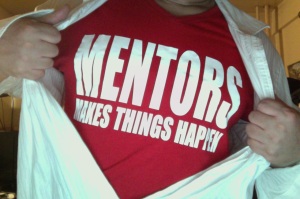While waiting for classes to begin at Teachers College, I’m serving as a graduate member of the Mentor and Leadership Development Program (MLDP). at my previous home, MCNY. One of the great things about doing so is that, while we are always helping students learn new things, we also get to learn new things…even things we’ve been doing all along.
One such lesson came near the end of the last semester. A student came to us asking about experiential learning—the process of “learning by doing”. While we were giving examples of this process, one of the mentors asked, “Is there such a thing as experiential teaching?”
That question had us scratching our heads. Can a person teach “experience”? Would they simply be using their experiences as anecdotal references in order to inspire their students to follow their example? Or can a person use their experience ‘in the moment’—that is, can someone reproduce the same conditions in which they learned a skill, and help guide a student through that same experience?
In her blog article, Jen Stanchfield notes that experience is an idea that not only can be used as a learning experience, but a teaching one as well. While the idea of experiential education is not new (see John Dewey and David Kolb), its use as a teaching methodology has been gaining in popularity, especially at the college level. Stanchfield tells us that people learn best when they are part of the learning process (what Dewey called active learners) rather than simply being fed information and tested on whether it stuck (passive learners). She takes Dewey’s idea and puts it into the 21st century, citing studies by Sousa (2005) and Willis (2010) that show learning and retention are improved when the learner is fully engaged (physically, emotionally, and socially) in the learning process.
As mentors, we aim to make the student (the “mentee”) an active participant in the mentoring process. It would be easy to just give the mentee the answer to a question and see if he or she remembers it later, but that would just be parroting. Because of the wide range of subjects and the diversity of our student base, we try to use the method that works best with each student, as no one method works for everyone. That said, however, the one that works most often is the use of prior experience.
Since all mentors are either current or former students of MCNY, our experiences with assignments or projects are still pretty fresh; thus, we can recall what steps were taken to reach the desired goal.
When a mentee comes to us seeking assistance, we draw upon that experience and use it as a guideline to help them solve the problem. It is very important to note that we do not do the work for the mentee; we show them how the work is done, asking if they understand the steps needed to finish the process. In this way, the mentees can work at their own pace, rather than that of the class. They are part of the process every step of the way, from their first contact with the mentor to the completion of the task at hand and beyond. They have invested their presence, time, effort and (in most cases) pride to make sure they succeed; it is not mandatory, so for them the reward is well worth the risk.
For the mentor, the reward comes in learning how best to usewhat we have learned in order tohelp others succeed as we have—not by lecturing them,but by guiding themthrough each step of the process. In doing so, we gain such gifts as patience, attention to detail, improved communication skills, and above all, teaching.
So yes, there is such a thing as experiential teaching. It can be seen in many areas, from the play areas of kindergartens to college internships to workplace apprenticeships. Whether we realize it or not, it also appears daily at the MLDP.

